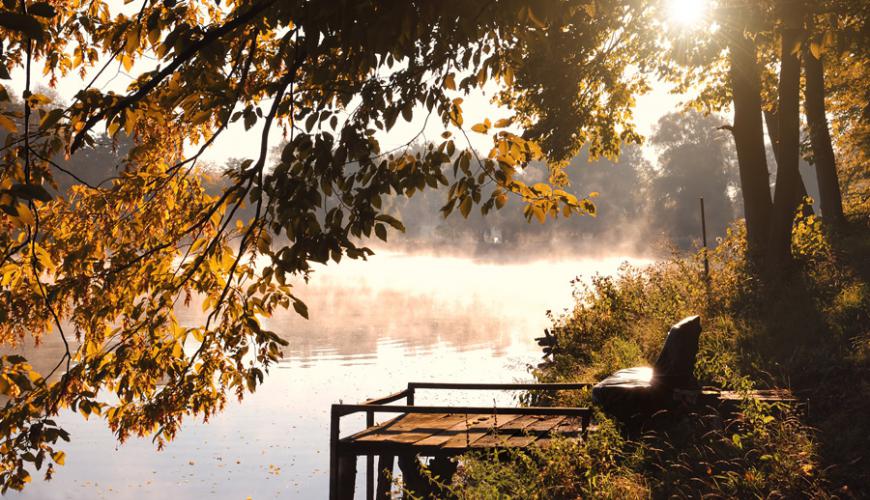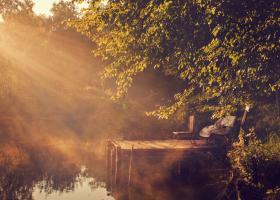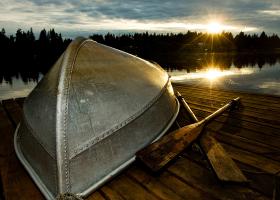Environmentally Healthy Shorelines in Muskoka

Many cottage owners now realize that something is amiss on their lake or river. They notice fish populations declining. They see fewer birds, frogs, and wildlife along the shore. They see more bank erosion, more shoreline heaving, huge trees along the shoreline starting to lean towards their house, and generally less and less of what attracted them to their cottage originally. They spend more time mowing their lawn, painting their shutters, and fighting Nature, than they spend fishing. They have unknowingly created a shoreland environment that is ecologically dysfunctional.
The shoreline environment is one of the most important ecosystems that affect the water quality of a lake. Vegetated shorelines filter the surface water runoff from upland areas. This runoff can carry harmful sediments, chemicals and nutrients that eventually end up in the lake. Shoreline vegetation can help stop and slow this potentially harmful surface runoff.
Shoreline vegetation also protects water quality by preventing erosion of its banks. This erosion can cause damage to fish spawning areas and may lead to a decrease in the value of your cottage.
The shoreline area also aids in overall lake health by providing a unique ecosystem in which many aquatic and terrestrial species depend during a part, or all, of their life cycle.
Lake Shoreline Restoration
If your property does not have an adequate shoreline buffer zone or has an altered shoreline, action should be taken to restore the area.
Shoreline restoration involves creating a new shoreline vegetative buffer zone and creating and maintaining water smart shoreline structures. To start, determine the width of the buffer zone needed for the topography of your property. Next, stop mowing this area and in a few months natural vegetation will begin to grow with no cost or time spent planting new vegetation. Hand weed undesirable or invasive species as they appear to keep them to a minimum.
Once your shoreline buffer is established, a narrow natural pathway to the water's edge can be created to replace large flagstone or wooden boardwalks. By reducing the width of the shoreline access route, it will allow for more natural vegetation to grow. By eliminating hardened surfaces, the flow of surface water runoff will be slowed. Both factors help protect water quality.
12 Simple Steps Toward Shoreline Harmony
- Protect shoreline vegetation - replant areas lacking shrubs and trees with natural species
- Start a buffer strip by leaving some grass uncut near the water
- Build at least 30 metres away from the shore
- Give clear instructions to your contractors and monitor their work
- Avoid spilling fuels, antifreeze, paint thinner or other chemicals on land or water - clean up fast!
- Don’t use fertilizers, pesticides or herbicides near the water
- Extend the life of your septic systems by avoiding tank additives and minimizing water consumption
- Refuel your boat with care - don’t spill a drop
- Watch your boat’s wake - it causes erosion
- Use soaps and detergents that are low in phosphates. Excessive phosphate levels cause increased growth of aquatic plants and algae.
- Make sure your septic system is maintained and the tank is pumped out on a regular basis.
- Maintain shrubs or trees in the area between your septic system and the water. Plants help absorb some of the nutrients that pass through your septic system.
Shoreline Access and Landscaping
As a waterfront property owner you need access to your shoreline for various activities. Any kind of regular access through your buffer to the water’s edge can have an impact on the sensitive soils and fragile banks, which are often associated with shorelines. You can minimize these effects with the following recommendations:
- Avoid a steep path that cuts straight down to the water; use gentle S-curve switchbacks instead
- On steep slopes, build stairs with landings instead of a trail to access the waterfront; stairs make shoreline access easier and safer, help your shoreline withstand frequent use and decrease erosion; strategically placed landings also give you a place to rest and enjoy the view
- Add a step or two on the trail, especially where the slope has a greater than 10 per cent incline
- When constructing trails, place them in areas where they will not interfere with runoff
Stairs, Decks and Other Structures
When constructing stairs, decks, gazebos or other structures, consider some structural procedures to make them environmentally friendly as well as functional.
Build a boardwalk, stairs or deck 10 to 50 cm over vegetation, with boards spaced 2.5 cm apart and no backs on stairs. This will allow sunlight and rain to penetrate between the boards, allowing vegetation to grow underneath; vegetation will keep soils intact and protect against erosion
Avoid removing ground cover from areas that may easily erode, such as areas beside structures
Try to use materials that are environmentally friendly and do not contain chemicals
Other tips for a healthy shoreline
Avoid using fertilizers, herbicides and pesticides on your property. Rainwater will transport these chemicals into the water, impairing water quality. Nutrients entering the water from the use of fertilizers cause an increase in the growth of algae and aquatic plants. When these plants die and rot, the process uses up dissolved oxygen in the water, reducing the supply of oxygen needed by fish.
A thriving plant and animal community on the water's edge contributes to another attribute: good water quality. Native plant communities in the water and on the shoreline filter rainwater and melting snow that drain into the lake for the surrounding watershed. When that water contains pollutants, the vegetation helps purify it.
One of the wonderful benefits of restoring your cottage shoreline is all of the birds and butterflies that will come for a visit. Most everyone has a favorite species of bird and butterfly, and the shoreline along the lake is a wonderful place to promote their habitat.
To create an environment friendly to birds along the lake shoreline, you are going to have to understand a certain amount about their lifecycles. Young birds sometimes eat vastly different things that do their parents, so to create an environment friendly to them it is best to plant those species of native trees, shrubs, ferns, wildflowers, vines, grasses, sedges, and emergent and submersed aquatic vegetation that will attract all ages of a particular bird.
Take a moment to assess the needs of your shoreline...
- Has more than 20% of your shoreline been altered or hardened?
- Has more than 20% of your in-water habitat been altered?
- Is your shoreline eroding?
- Is your break wall or dock constructed of creosoted or pressure treated lumber?
- Do you have spawning areas along your shoreline?
- Do you leave a minimum 3 metre buffer of natural vegetation between your lawn area and the water?
- Do you have non-native invasive plant or bird species on your property?
- Are you planning to do work in or near the water?
- Do you use pesticides, chemical fertilizers or high phosphate cleaning products?












